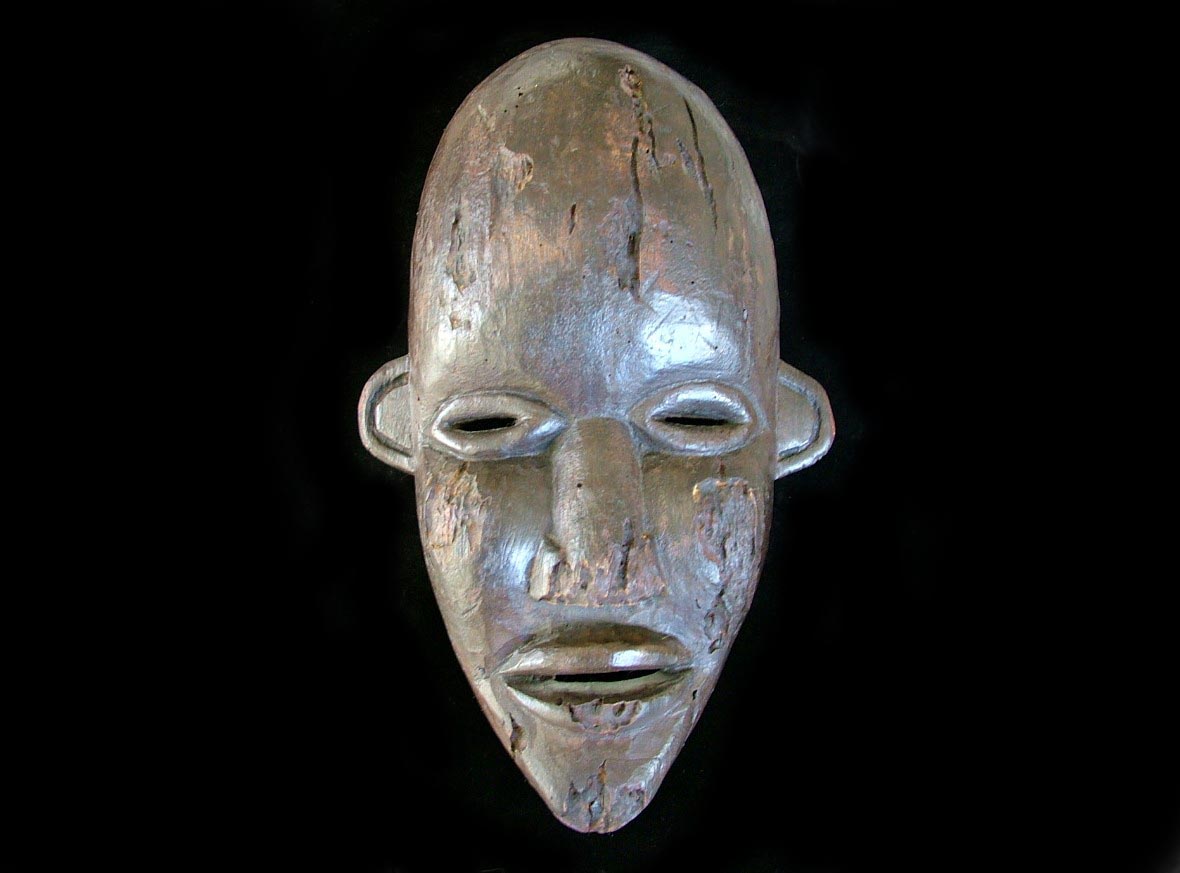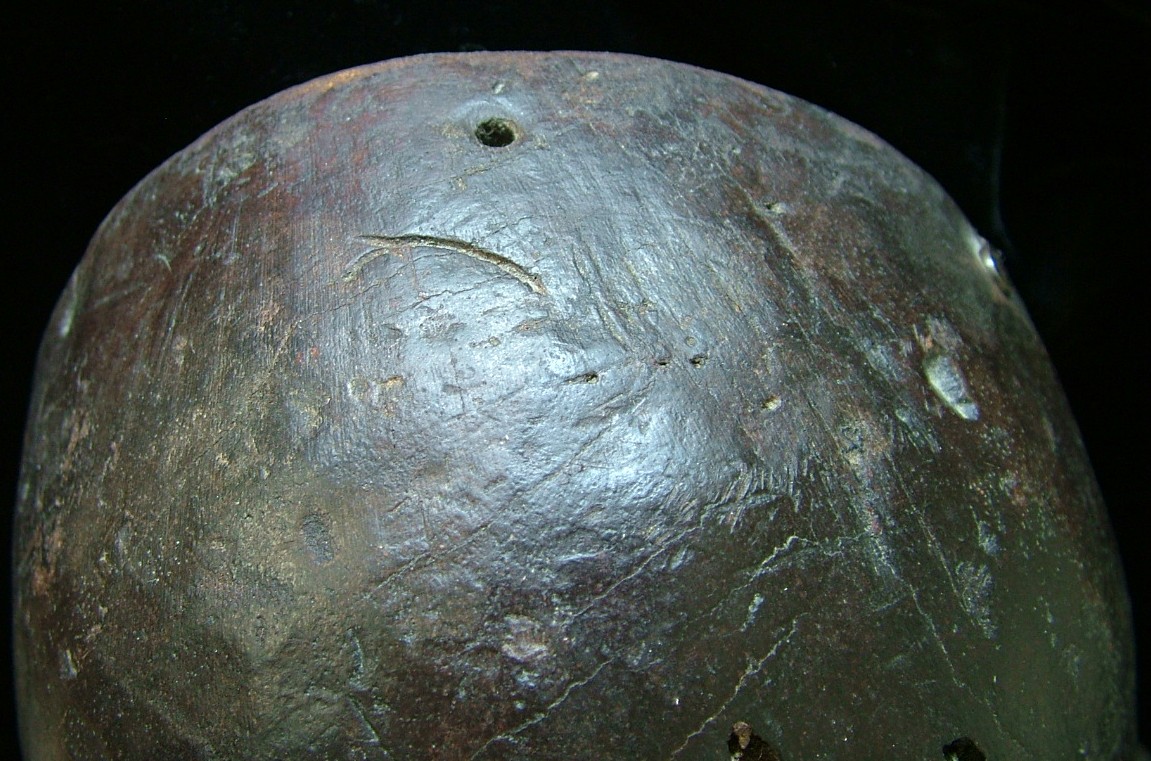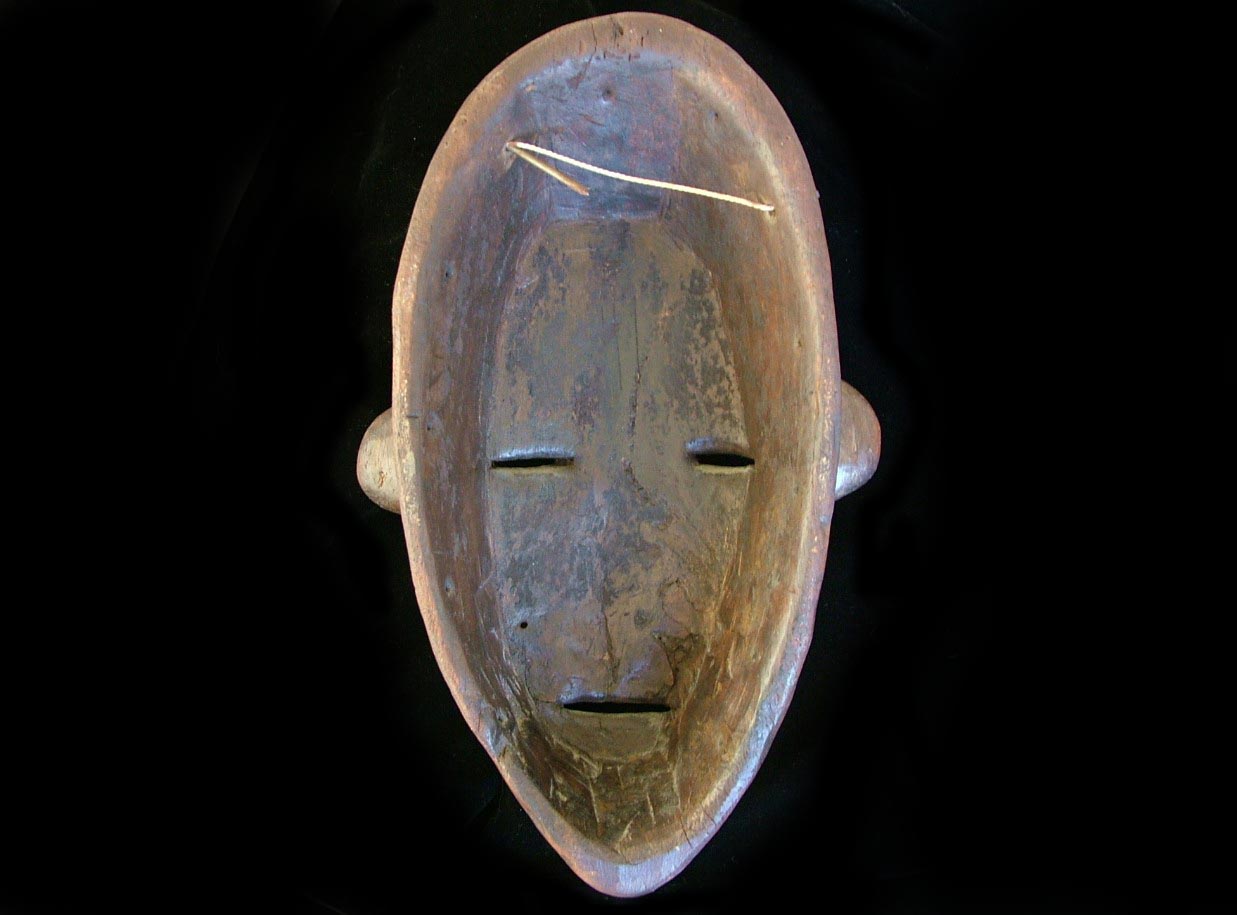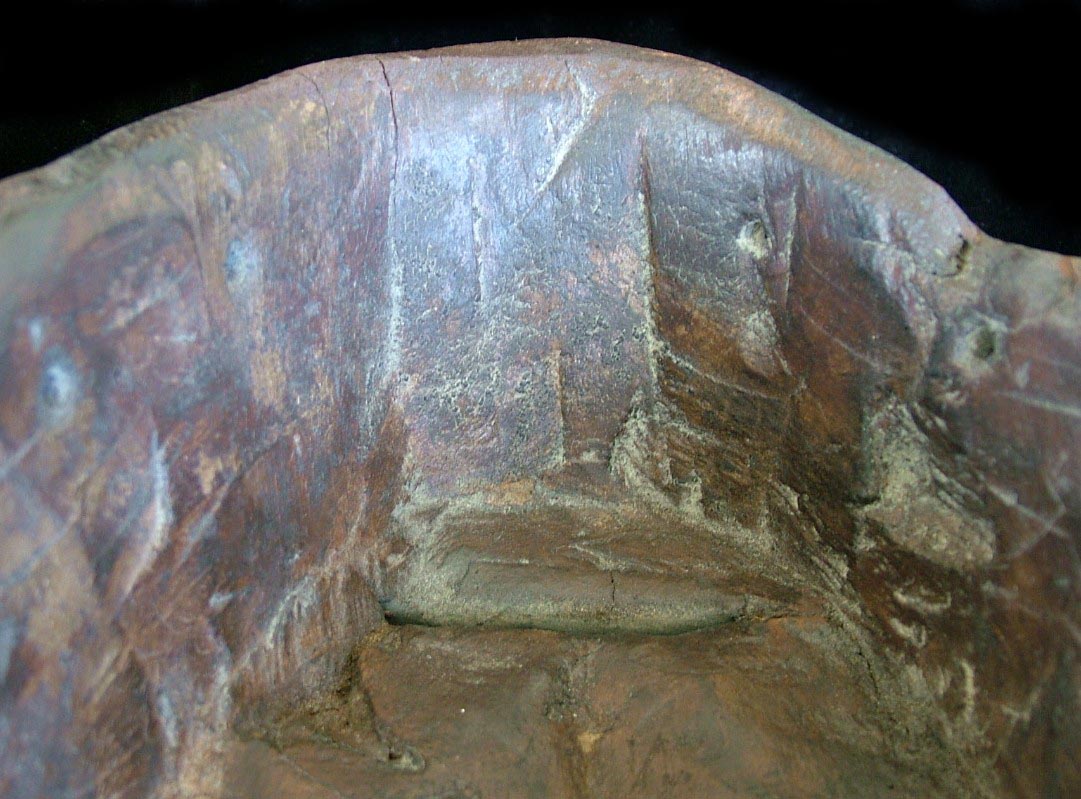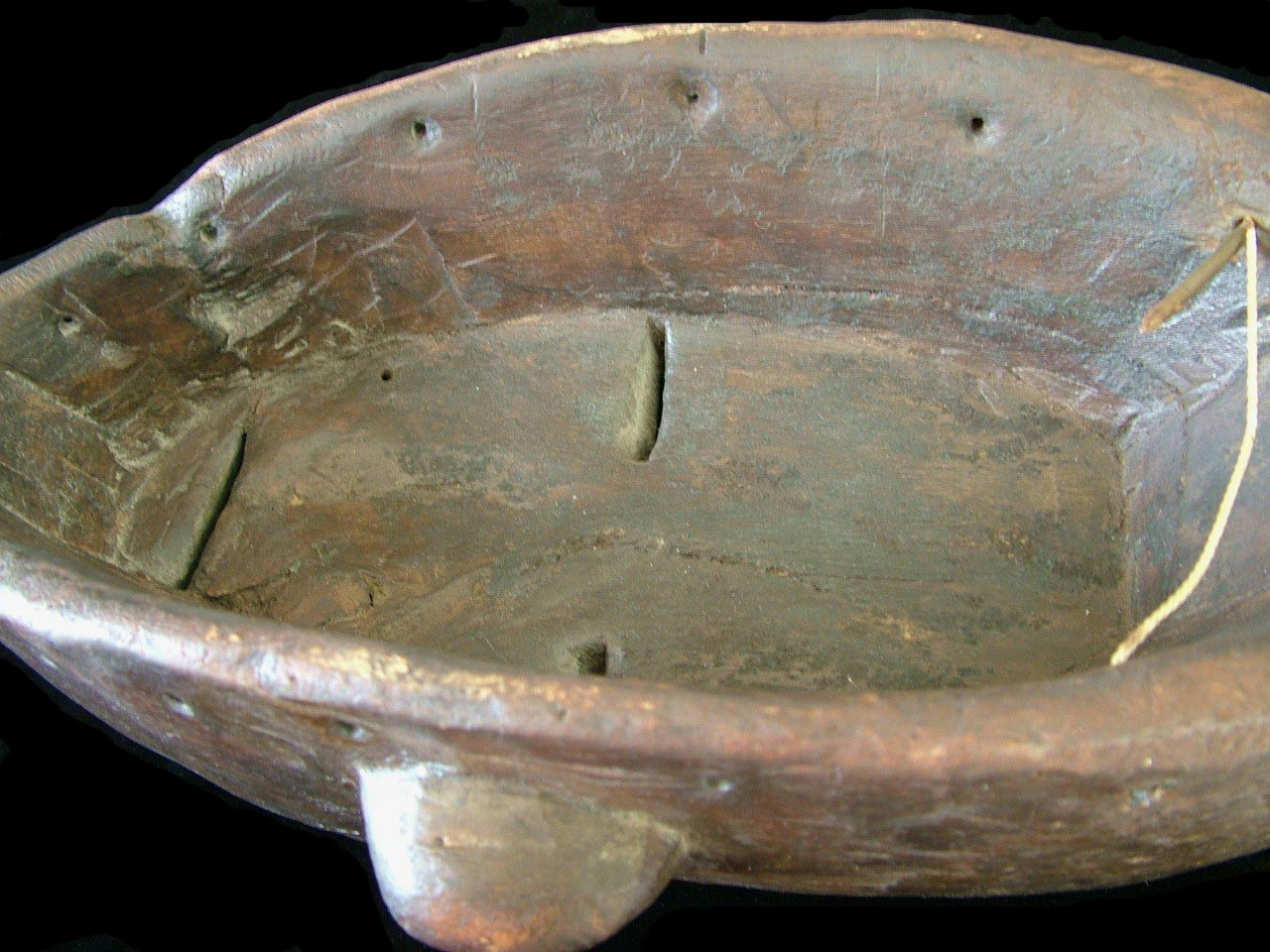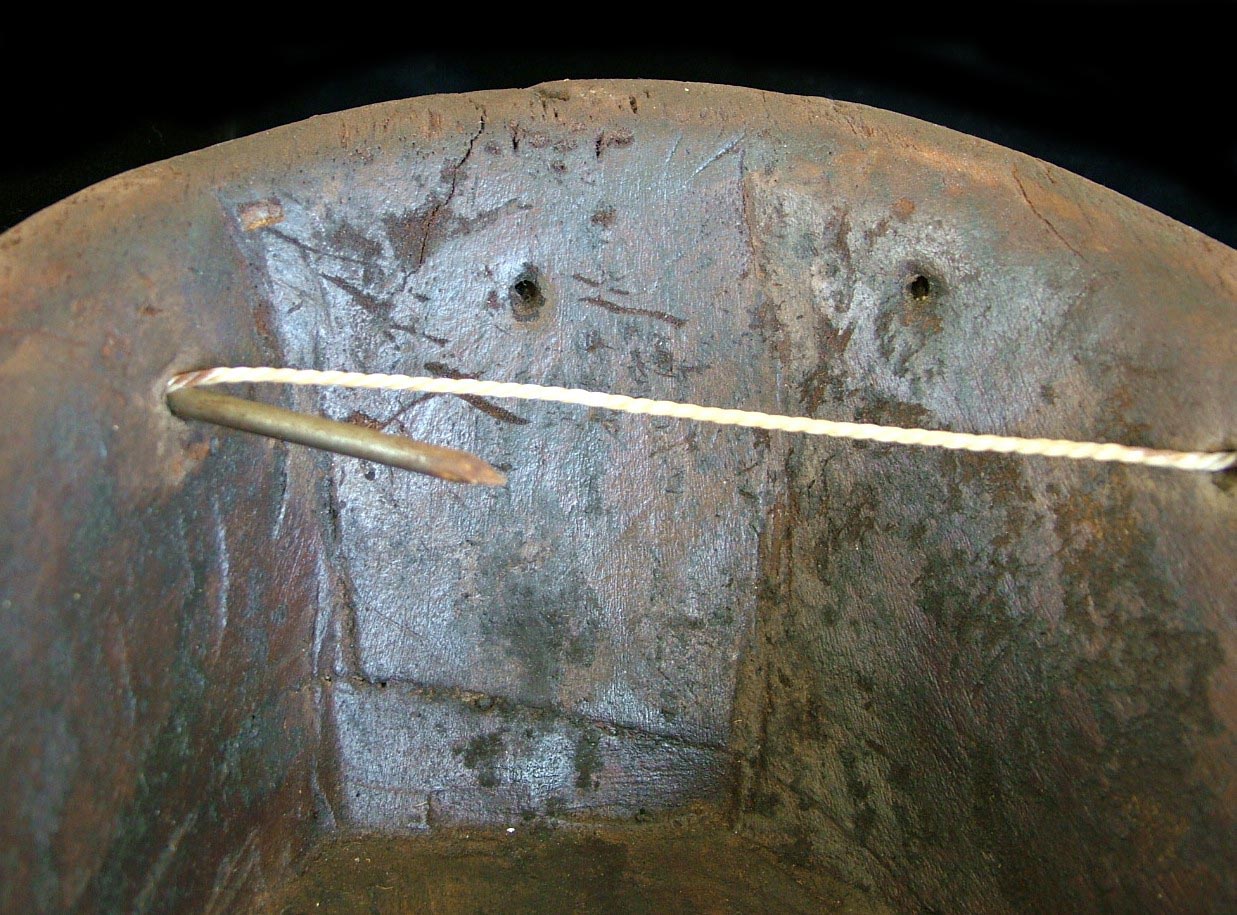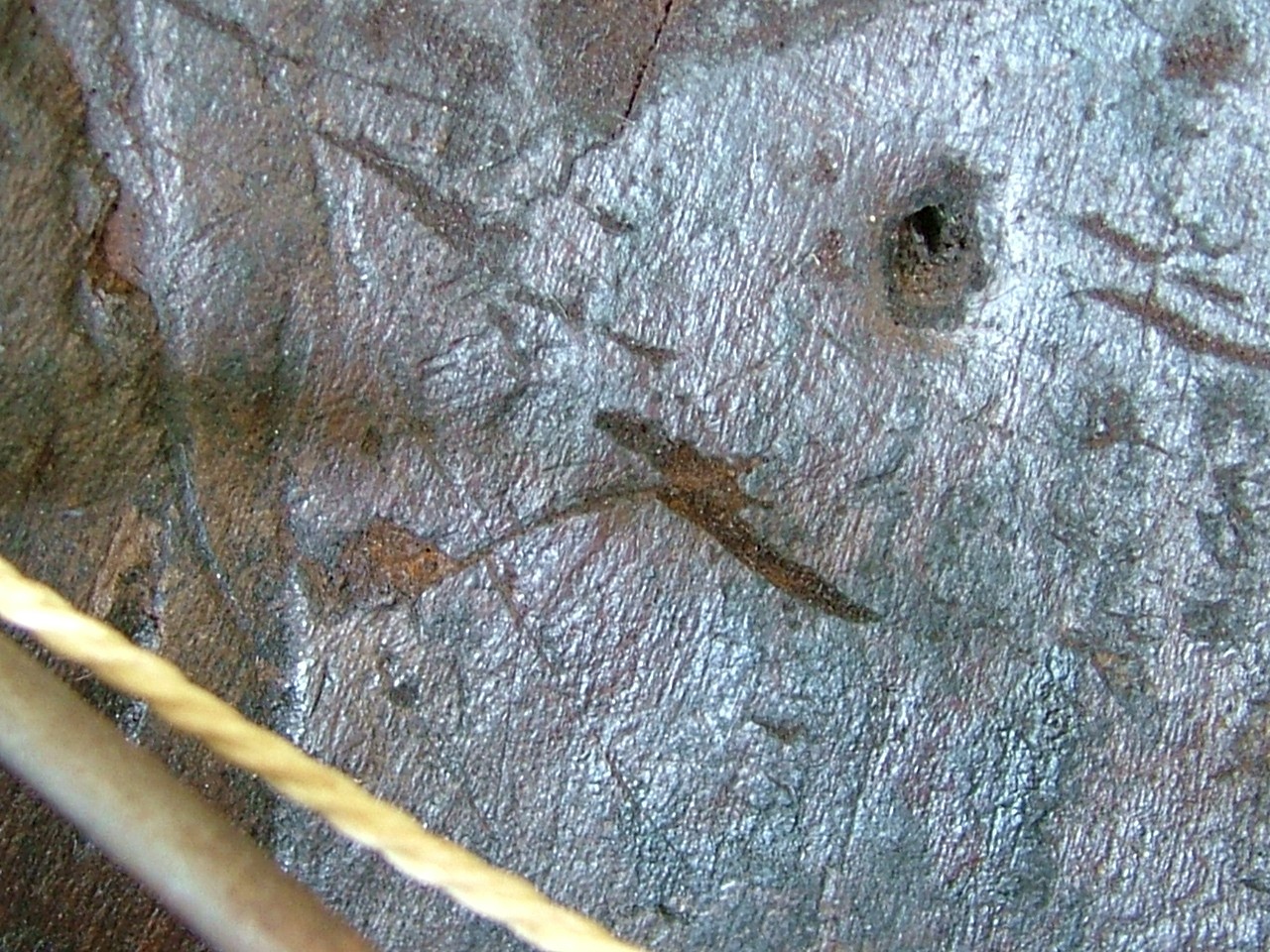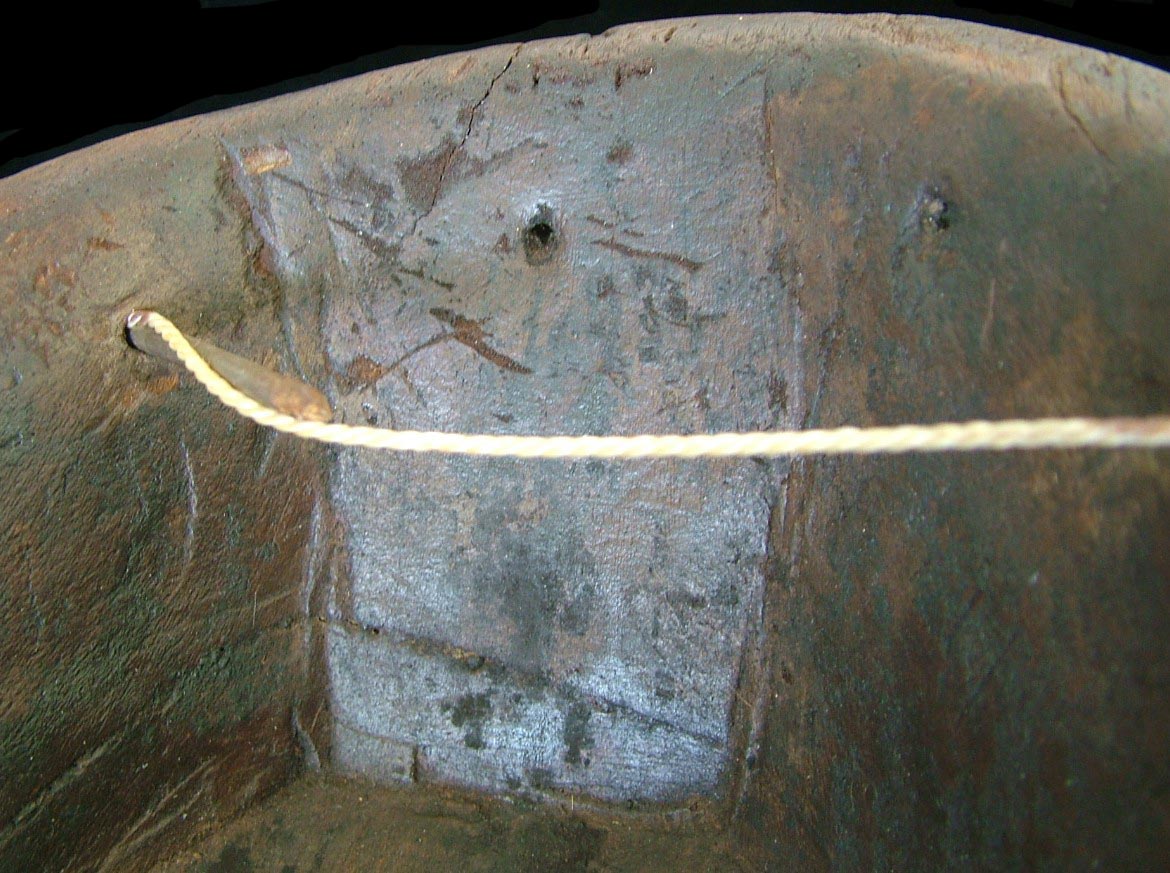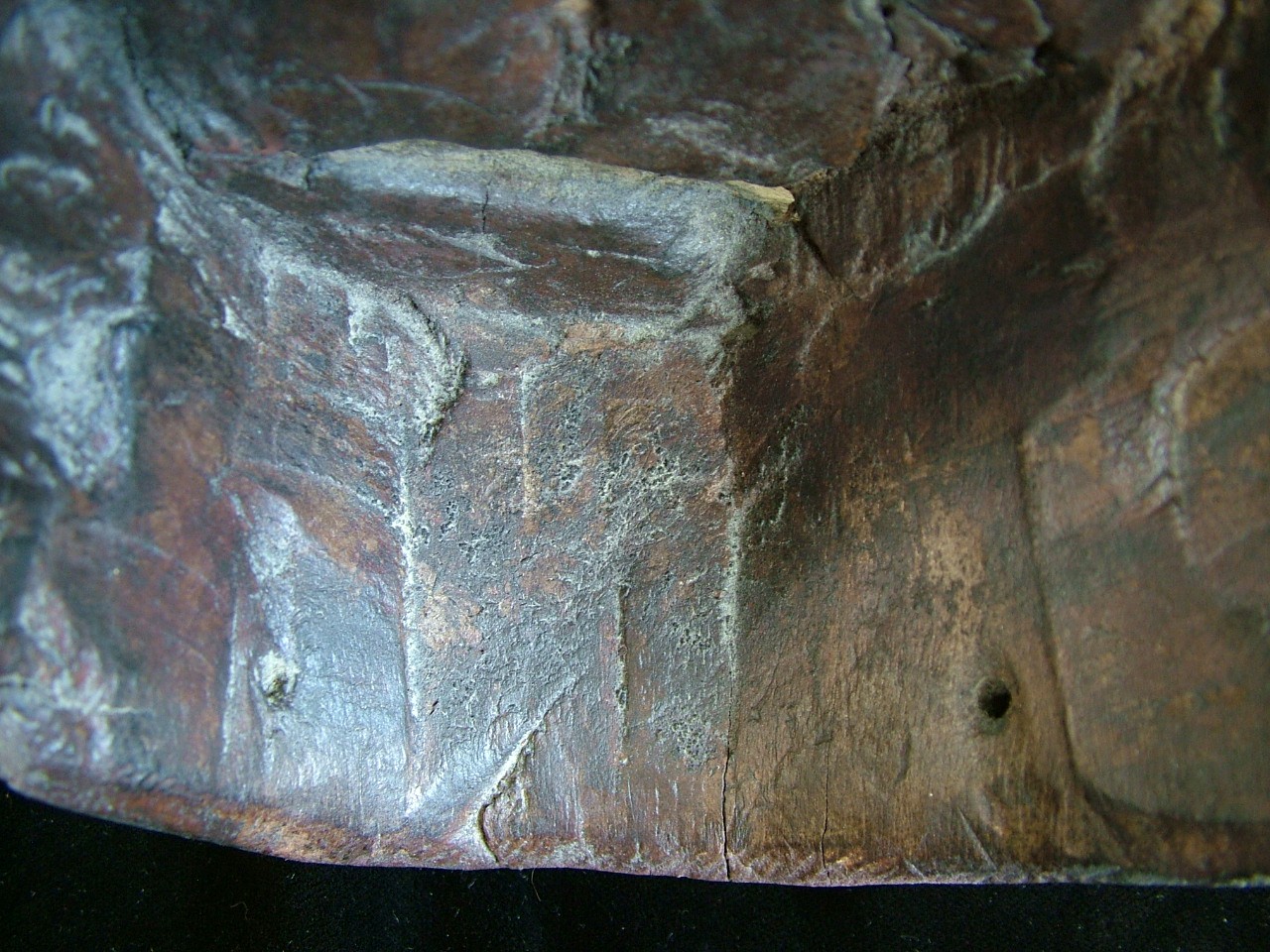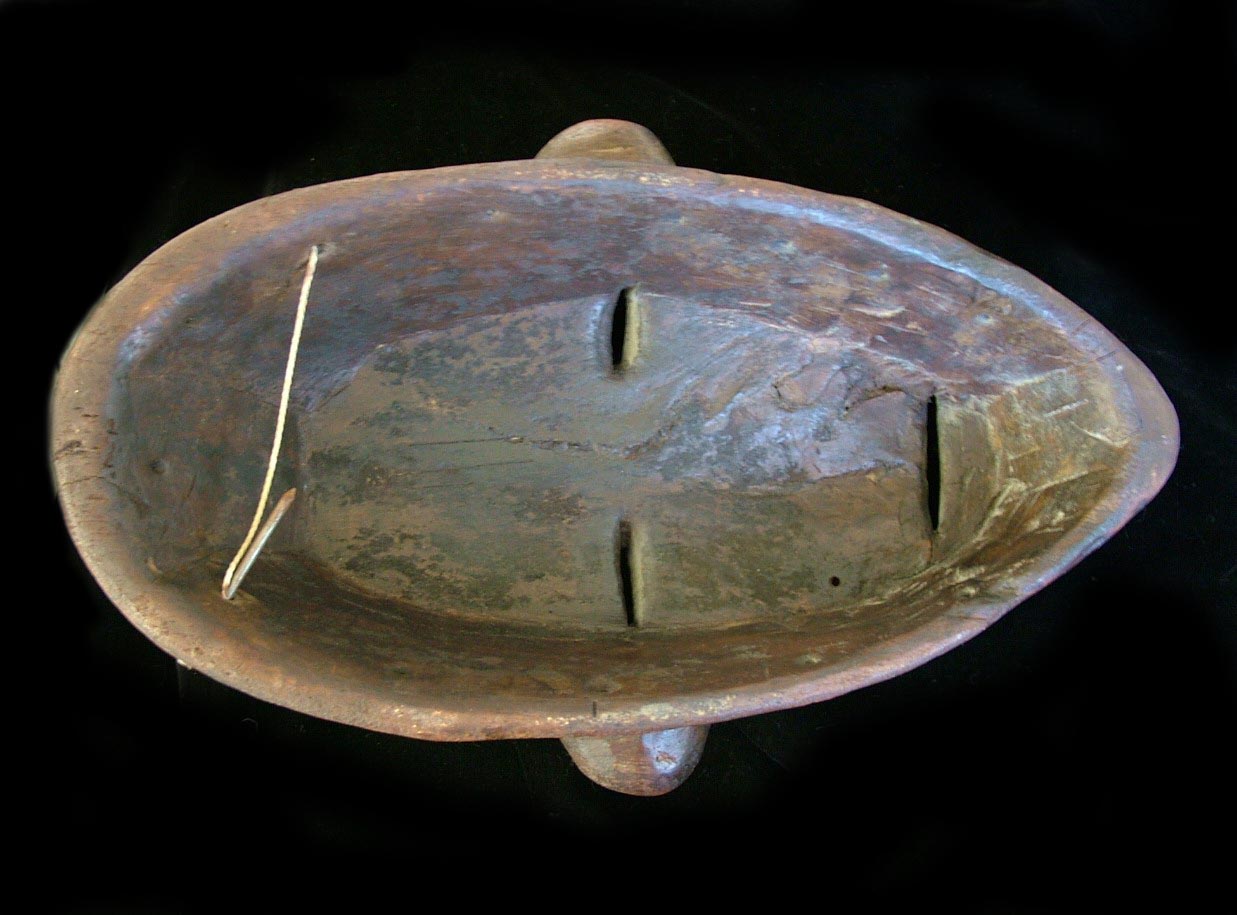 |
|---|
HAITIAN SLAVE REBELLION/REVOLUTION VODOU MASK OF THE WAR DIETY OGUAN AND THE MAROON F. MACKANDAL |
|||||||
| HAITIAN SLAVE REBELLION/REVOLUTION VODOU MASK OF THE WAR DEITY OGUAN AND THE MAROON F. MACKANDAL |
|||||||
|
Picture of Mask and Detail Pictures 1
According to some African masks are not supposed to have been known in Haiti before the 1930's, this mask in unique but it also suggests that at least some did exist, but were hidden from the public view. I can state that the mask's condition and the style of certain miniature art appears to be two hundred and fifty to two hundred years old. The art on the mask itself is in layers and appears to have been made over a period of ten to thirty years. The mask is of a Vodou belief system that is synchronized from West African deities, a couple of Christian saints, the Kingdom of Dahomey, and Slave Revolt/Haitian Revolutionary War figures. The West African deities are of the following tribes, the Yoruba, the Fon, and the Baoule. The mask has the following themes: The date of the execution by fire at the stake of the escaped slave Maroon Rebel Leader/Sorcerer Francois Mackandal, a secret slave brotherhood that appears to be have been named the "Cinq Freres du Poignard de Flamming" ("Five Brothers of the Flaming Dagger"), the flaming dagger meaning "the Dagger of Mackandal", the Vodou ceremony at Bois Caiman, the storming of the Bastille and the French Revolution, the Slave Revolt Leader and Hougan Dutty Boukman, the Slave Revolt of 21/22 August 1791, a pig or wild boar sacrifice and possibly the Mambo Cecile Fatima*, the Revolutionary Leader Jean-Jacques Dessalines, the Revolutionary War Leader Toussaint Louverture, the Haitian smith/war god Oguan (the Ogun of the Yoruba) as St. Jacque (St. James the Greater), the thunder storm god Shanga, a Hessian boot, the white gorilla god and judge of the dead Ghekre, a tree spirit (most likely of the Mapou tree**), three Dahomian kings of the late 17th C. and the first half of the 19th C, the female fertility water spirit Mami-Wata, the Gbeto of the Dahomey (the Black Amazons), zombies, a ship that with the fourteen holes (symbolizing gun ports) turned into a war ship (the mask itself), a right footed wooden shoe (the mask itself), a serpent with a man's head, a flaming dagger, drum, a Vodou sacrificial knife, a pig, a sacred sword in the stone or mound (of the god Gu of the Fon, the equivalent of Oguan, in this instance he is associated with Toussaint), a sacred meteor/meteorite blade impact event of Gu, a long saber or long machete (that hints of an executioner's sword), a boar's tusk, a straight razor, a crocodile (caiman) that is also pincers, a flag, a cavalry guidon that is also a burning torch, a cannon, a whip that turns into an elephant tail whip that also has an elephant horn that is an antelope horn (when the mask is moved the whip turns into a torch), the first digit of a finger that is also a slipper of the late 18th C., a shark, and a late 18th C. to early 19th C. French riding boot with spur. The mask is a motion artifact as when it is placed on a smooth surface and held down by it's chin, then let go, it will initially rock back and forward with a couple of loud claps, then it will quickly clop back and forth, then stop (the entire movement and sound will last for only seven seconds but it is; mechanical, loud, and exact), it sounds exactly like a galloping horse. This should represent Ogoun as St. Jacque (St. James the Greater) who is a Cavalryman. What may or may not be a factor, is that when the numbers one thru fourteen are very quickly spoken in most languages it takes roughly seven seconds. Note that the shape of the mask and it''s motion is rather similar to the Merlin Necklace seen with "Ancient European Arthurian Related Artifacts", but it's motion and it's connection to blade weapons is also somewhat similar to the "Warring States Sanxingdui Dao Sword" seen with "Other Artifacts Of Interest". These similarities may be coincidental, but if not then they could lead to at least a few speculations. There are also suggestions that Toussaint may have been seen as an African/Haitian King Arthur. Other considerations that may or may not be included are of the following: Don Petro the founder of Petra Vodou, the American Revolution, the Chasseurs-Volontaires de Saint-Domingue, the Revolutionary Leader Henry Christophe, the French abolitionist group the "Society of the Friends of Blacks", the Jacobins, Napoleon (and, or General Leclerc), the Polish Legion (the 113th and 114th Demi-Brigades), the Citadel La Ferriere, and Christophe's Dahomian Royal Guard. The Kings of Dahmony whose symbols may be associated with this mask and their connection to the Gbeto:Houegbadja who ruled from 1645 to 1685, his symbol was a fish. He purportedly founded the Gbeto as a worshipful band of female elephant hunters, he also founded a female Royal bodyguard from some of his wives. Akaba who ruled from 1685 to 1708, his symbol was a warthog. He had a twin sister named Ahangbe that according to some traditions was a co-ruler that led the Dahomian Army in a battle, if so then such an event may or may not have something to do with the idea of developing the Gbeto into soldiers. Agadja who ruled from 1708 to 1740, his symbol was a European carvel boat. He purportably expanded the Gbeto into an elite militia regiment comprised of virgin and celibate female soldiers. More Info.This is a Saint Domingue/Haitian Wood Vodou Mask of the War god Ogoun, other gods/spirits, and apparently Francois Mackandal. It is 36 cm x 23 cm. It has been engraved, worked with charcoal, and with minute amounts of paint and wax. It was purchused in Miami in 2000, it was purported to have been found in a Haitian barn many years before. It is identified as such by the iconography of the wood and wax engravings inside the mask. Although I have researched the history of West African peoples and the Haitian people, I have minimal knowledge on Vodou as a religious belief system. The mask has cracks and age marks with various miniature engravings inside and outside of these. Some of the cracks have bits of various types of organic material that appears to be from animals that have been worked, there are also a few dabs of red wax, the entire mask has a thin wax coating. There are fourteen holes (that are 3 to 4 mm in diameter) around the edge of the mask, these appear to have once been for holding a padding and string net as to secure and fit comfortably on the wearer, they were added later (possibly after the start of the French Revolution (14 July 17789) or the Saint Domingue Slave Revolt (14 August 1791). The mask has two thumb holds that show that it was originally held in front of the face while sitting or standing. There is a early to mid 20th century steel nail in a hole that has a white nylon string attached to the hole on the opposite side of this mask where there is part of a match stick inserted into that hole, this additions also have miniature art. Of note with the pictures seen with this group of the outside of the mask is the engravings on the forehead and between the eyes that are in a vertical line. There is a large letter "P" (with an "O") that is also an "F" and an "R", a large number "5" and an "8", a "17" that has a "J". Although not seen here if this area is seen from the side then it will show the numbers "20". This should read "Cinq Freres du Poignard de Flamming" ("Five Brothers of the Flaming Dagger", January 20th,1758. The date is that of the execution at the stake of the Leader/Sorcerer Francois Makandal aka "Makandal the Poisoner". Over this and part of the vertical line of engravings there are other engravings that are unintelligible due to the cracks, it is evident that all the vertical line engravings were engraved prior to the wood attaining it's age cracks. The mask itself is made like a ship (this is particularly so with the inside), but also as a right footed wooden shoe up to an American male's size 10 1/2. It could be speculated that the right foot was associated with a swordsman, as a swordsman usualy leads with the right foot. The engravings and work in wax on the mask appear to have been made during two main periods: On the outside from 1758 to 1789 and on the inside from 1789 to 1805 (or perhaps until 1820). The steel nail appears to have been engraved and painted at some time during the early 20th to the mid 20th C. The nylon string and the match stick piece appears to have been added in the mid 20th C. The nail, string, and match stick piece may be of the more passive Rada Vodou system, if so then it could be seen as containing the aggressive and violent Petra Vodou symbolism. The organic material in the cracks, wax, as well as a few engravings inside the cracks appear to be of the first half of the 20th C. It is evident that whoever put these three items on the mask and the work on the inside of the cracks understood the primary nature of the mask's symbolism. At some point in the last forty to twenty years someone dyed the mask a darker color as the wood seems to have once been naturally lighter colored, this suggests that they may have not understood the complete meaning of the mask's immense symbolism. *The blood sacrifice of a pig is traditionally supposed to have taken place on 14 August 1791, although this is now disputed by some. The iconography on this mask states that it took place on the night of 21/22 August 1791.**The Mapou tree is a sacred tree in Vodou. Considering the Mackandal and Bois Caiman symbolism on this artifact then the mask may be from the wood of a tree that was on the Lenormand Plantation. |
|||||||
Detail Pictures 2
|
|||||||
| This group of picture's is of the mask's outside top and of it upside down. The mask's outside top has engravings. The lighter engravings appear to have been done earlier then the engravings on the inside. There is a distinct deeply engraved "Y" type symbol that may have been engraved when the mask was first made. When the mask is turned upside down and seen from the nose down then it appears as a gorilla or monkey face. This should be the white gorilla god Ghekre of the Baoule tribe, Ghekre is a god that judges the souls of the dead much like the ancient Egyptian god Anibus. |
|||||||
Detail Pictures 3
|
|||||||
|
This group of pictures is of the mask's inside. The mask's inside overall shape in this position hints of a shrine. The inside shows a vertical sword in the stone (or mound), it is heavily disguised and at a glance could appear as planks (perhaps of a ship's deck or bottom deck). The sword has a rib, but is actually two blades being placed together, there are various figures on the or near the sword's hilt. The top of the sword has a type of cross bar, this makes for the letter "T". To the right of the opening of the mouth is a boar or warthog's tusk. Over the opening there is a 18th C. dirk (dagger) with a twisted blade (flaming). Upside down the mask's inside shows a tree with figures that suggest spirits, this must be the Mapou tree. Then the dagger upside down that has a scene and figures on the hilt. The bottom of the tree shows an "L". The symbolism with this should represent the two pieces iron placed together of the god Ogun (Oguan) of the Yoruba tribe, in this instance it the iron pieces make the blade of a sword. As a sword in the stone it should represent the sword of Gu (Oguan) of the Fon tribe. According to the book "Africa's Ogun, old world and new" by Sarah T. Barnes this represented the sword of creation that was given the praise named "ali-su-gbo-gu-kle", it translates as "the road was closed, but Gu opens it". In my opinion this is the actual meaning of Toussaint Louverture's last name, as L'ouverture means in French "the opening" although as a nickname or title it could also mean "The Opener". The "T" on top on the sword hilt and the figures suggests spirits, they may represent Christian saints as Tousaint was born on All Saints Day and one of his names Toussaint was for that day, Toussaint means "the awakening of All Saints". The "L" on the bottom of the tree when upside down no doubt is for Louverture. Although Toussaint was born François Dominique Toussaint Breda, in 1793 Toussaint signed his name as Toussaint Louverture. For two hundred years there have been many speculations as to the exact meaning of why Toussaint had taken this last name, what is on this mask may be the answer. Although Toussaint was known as a devout Catholic it would seem that he may have appealed to those with Vodou or Vodun beliefs, without a doubt such beliefs were popular with the slaves were mostly African, but later on they were also most likely popular among the rank and file of his army. A hint to the latter is that the Englishman Marcus Rainsford wrote (from that period) that Toussaint had an "extremely large sword" at his side. This hints that Toussaint may have been showing his Vodou/Vodun belivers that he had a solidarity with the sword god Oguan/Gu as "The Opener". If Toussaint's sword has survived and is ever found, then I think that it is probable that it would bear at least some engravings of the god Oguan and, or Gu. |
|||||||
Detail Pictures 4
|
|||||||
| This group of pictures shows the bottom chin area of the mask on the inside. The engraving, wax work, and charcoal work is in layers and may have been done in layers over a period of ten or ten to thirty years. It shows the following in layers: An "S' and a "D" (Saint Domingue), an "S" and a "J" (St. Jacques), "J", "U", "L" and "14, 1789" (14 July,1789, the date of the "Storming of the Bastille" of the French Revolution), "B" but also "BOS C" an "A", "U", "G", and "14, 1791" (Bois Caiman, 14 August, 1791, the place and date of the Vodou Ceremony of the Slave Revolt) - The letters "BOU" may also be seen as representing Boukman, the Vodou Houdan and Slave Revolt Leader leading that ceremony, the "O" should also be for Oguan. There is also a large "H" (Haiti). There is also the following; A hatchet (a hatchet was used on a bridge as the first act of aggression on the storming of the Bastille fortress, but it could also be a symbol of Shango), the letter "S" as a serpent with a man's head (this should be Shango the thunder god, according to tradition both Shango and Oguan were invoked at the Bois Caiman ceremony), a Hessian boot (a typical military boot of the 18th to early 19th C.), a figure in profile with a bi-cornered hat (this may represent Napoleon or General Leclerc, or both men), and a Vodou drum. On the left side in front of this area there is a semi-nude long haired woman/mermaid with a bird headdress, fish tail, and holding a "V" object that is facing the inside chin area. Behind her is a long line of figures that are also huts over a tooth. Then there is a late 18th C. French pointed toed short boot with a rolled top and spur. The woman should represent the Mami-Wata a fertility spirit that usually has light skin, and straight black or blonde hair that is pulled back, she is a water spirit that is associated with fertility and wealth - In this instance she appears to be a type of "African Joan de' Arc" coming from a marsh and a village. The "V" object that she is holding has a type of line doll on it, it should be a fetish, most likely a cursing fetish. The tooth is from the boar or warthog's tusk (seen in the previous group of pictures) and very much resembles the outline of the continent of Africa. It seems that among the slaves of Saint Domingue that the boar or warthog's tusk (or anything carved in it's form) may have been a secret symbol for Africa. The boot is over the tooth so it is likely that this represents French or European domination over the Africans. With that said, the spur appears to be of or connected to a long thin sash, it is if it is being pulled back towards the chin area. This suggests that the rebelling slaves of Saint Domingue had a long range notion of freeing Africa from European or outside domination. |
|||||||
Detail Pictures 5
|
|||||||
| This group of pictures shows an engraved whip when seen from the top, when the mask is tilted on it's side it turns into a torch. As a whip it will turn into a longer whip with a flaired tip, it is in fact an elephant tail. The elephant tail was the primary trophy of the elite African women warriors known as the Gbeto (Black Amazons). The flair of the elephant tail in front of the chin area has the following: An elephant tusk that is also an antelope horn, the antelope horn is a primary symbol of the Gbeto. The horn is as if being inserted behind or into the Vodou drum/lower portion of the figure in the bi-cornerd hat on the chin area. There is a long saber that is also a long machete behind the figure in the bi-cornered hat (the long saber is another symbol of the Gbeto), there are suggestions that it may be an executioner's sword, there are several smaller figures on the bottom as if wielding the large saber/machete. Behind this is a small figure in a tall hat near the hole that is wielding a short sword or machete, there is a head as if coming from the hole and going into a basket. Behind this is a large roundish mermaid type figure, she may represent another form of the Mami-Wata and or a puffer fish. At the beginning of the horn (the beginning of the flair and thickest part) there is a large rodent head in a pointed night cap (the night cap suggests that it is a creature of the evening). Over-layered on this is the outline of a woman, her lower half on the rodent's head is a large bird's head that is also like a flowing scarf. She has a small spear that is directed at the roundish fish, so she is either spearing the fish or perhaps even extracting a substance from the fish. Inside the rodent's head there is a man's head. There is every indication that the rodent/man is someone who has been zombified by a puffer fish*. All these symbols put together suggests that this is a form of biological warfare using zombies against the Colonlists. There are indicators that it was thought that the Gbeto were either experts of the zombification process or that they were the originators of such a practice. There are also hints that certain sympathetic Mulatto mistresses (perhaps as incarnations of the Mami-Wata) of male colonists may have been seen as the Colonist's Achilles Heel. The last pictures show the front of the chin area from the side on the outside. It shows that there are beaded wavy line engravings around the mask, these are like the waves around a ship. There is one area that shows a small amount of white animal fur or wool in a crack. *According to the Harvard ethnobotanist Wade Davis an extract from the puffer fish is a key ingredient in making the formula for zombification. |
|||||||
| Detail Pictures 6 |
|||||||
| This group of pictures shows the following. The inside back of the head area (there are other pictures of this area with more details with the next two picture groups. It shows the steel nail inserted with the nylon string in a hole on the left. The focus with this pictures is with the piece of a match stick that is inserted into the hole that has one end of the nylon string on the right. The matchstick has burnt and twisted work on it. There is little doubt that his something to do with Ogoun as the smith god and fire worship. |
|||||||
Detail Pictures 7
|
|||||||
| This picture group once again shows the inside top of the head area. There is a focus with a line figure yielding an African ceremonial knife and the steel nail. The knife is a specific type that only an expert in African ceremonial weapons may be able to identify, but it appears that it may be an African Vodun knife (Vodun is where Haitian Vodou and the Voodoo of New Orleans derives from). The steel nail has been worked with small amount of paint and dyes. It represents a dog, ram or goat headed meteorite. On the head of the tip there are several figures, they appear to be a mix of European and Haitian figures. |
|||||||
Detail Pictures 8
|
|||||||
| This group of pictures shows the following. The inside back of the top of the head. There is a flag and a cavalry type guidon that is also a burning torch. On the guidon has a head wearing a pointed hat. The line figure yielding a knife shows that it is carving the number 21 that when slightly turned transforms into a 22, these are evidently the dates of the night and day of the actual Slave Revolt. The entire area on the back could be seen as a guillotine. A slightly overhead view shows an engrave whip. On the bottom there is a late 18th to early 19th C. type straight razor. The straight razor is associated with the Gbeto and their beheading (and more) of enemies. When moved inside the razor shows pincers that are also a crocodile (caiman). There is a figure on top of a box, it may be of a woman with a large head, in one position she may be holding a cannon ball, there is also a hint of a cannon or a gun coming from the box. When moved the bottom of the straight razor shows a veiled figure as if in type of coffin, there are figures as of coming from the razor handle's opening. The left side shows the first digit of a finger that is also a late 18th C. slipper. The finger digit/slipper may also be a dugout boat, it has a shark and a whale biting it from the front and the rear. There is no doubt that there is a connection with the finger digit, the straight razor, and what is possibly a guillotine. |
|||||||
|
| |
Detail Pictures 9 |
This group of pictures shows the following. The front chin area on the inside upside down. There are standing figures, a swastika, the number's 1 and 4 (14), standing figures, a castle turret (possibly representing the Bastille), and possibly a letter "H" (Haiti). The back top area upside down shows a hanging banner with a fortress and figures on top. On the banner is a large figure that may be connected to a Christian Saint, it may be of also be of a woman. The line figure that is yielding an African ceremonial knife is now sacrificing a pig or a wild boar. This area seen with the mask on it's right side shows the following, a cauldron, a Vodou drum, a large face in profile with a tall hat (that may hint of a French or French Polish soldier). The mask's inside seen on it's left side shows a torch. In the torch's holder there is a standing woman with a couple of smaller figures, there is a hint that this may be a resurrection scene.
|
Detail Pictures 10
|
This group of pictures shows the mask on the inside on it's left side and on it's right side. The scene on it's left side may or may not be of a scene from Africa. The scene on the right side is of the actual god Gu as a two pieced blade with a thin hilt that is from streaming from an arch (that may also have a mountain or a hill under it) and impacting the ground, the arch is coming from near the top inside end. Copyright 2009 David Xavier Kenney | ||

